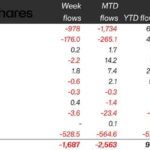As Bitcoin (BTC) stabilizes around its 200-day average of approximately ,000, the cryptocurrency market is experiencing a notable shift, particularly influenced by the recent activities surrounding memecoins, layer-2 tokens, and gaming tokens. After a dip below ,000 last week, these new trends have spurred some recovery, yet underlying challenges remain, especially with the current political climate.
In a weekend statement, Treasury Secretary Scott Bessent acknowledged that market corrections are a natural part of economic cycles, suggesting that the anticipated support from President Trump’s administration may be less forthcoming than traders had hoped for. The mood shifted when Bessent indicated that a recession was still a possibility, contrasting sharply with the usual optimistic rhetoric from government officials during tough times. As concerns about tariffs linger, Bitcoin’s resilience could be tested, particularly if traditional equities continue to falter.
“I can’t picture a scenario where risk assets crash and crypto remains unaffected,” Greg Magadini, a director at Amberdata, summarized, highlighting the interconnectedness of asset classes in these turbulent times.
Furthermore, broader economic sentiments are shifting, with many consumers expecting worsening conditions over the next year, which could dampen enthusiasm in both cryptocurrency and stock markets. Traders are closely monitoring the upcoming Federal Reserve meeting for potential economic stimulus, particularly in light of Chairman Powell’s caution concerning the implications of Trump’s policies.
On the decentralized finance front, notable developments include Aave Labs’ decision against introducing a new token for its Horizon project aimed at integrating real-world assets. As cryptocurrency evolves, significant events on the horizon include the launch of Solana (SOL) futures and several crucial network upgrades, drawing attention from both developers and investors alike.
In exciting market movements, the BNB Chain has witnessed record trading volumes, overtaking those of Ethereum and Solana as new memecoins generate fresh opportunities. However, caution prevails, with various altcoins displaying contrasting trends in funding rates and investor behaviors.
The landscape remains dynamic, and as we navigate through fluctuating market conditions and global economic uncertainties, the cryptocurrency industry continues to be a focal point for many financial observers and participants.

Bitcoin Market Update and Macro Insights
This update highlights the current state of Bitcoin and relevant macroeconomic factors impacting investors and traders. Understanding these elements can help readers navigate potential market challenges.
- Bitcoin’s Stability:
- Bitcoin has stabilized around ,000, recovering from a dip below ,000.
- The recovery is led by memecoins, layer-2 tokens, and gaming tokens.
- Market Sentiment:
- There is a deterioration in sentiment among consumers, with many expecting worsening economic conditions.
- This sentiment can lead to increased risk aversion affecting both crypto and traditional markets.
- Political Climate:
- President Trump’s administration exhibits higher tolerance for market instability, affecting crypto investor confidence.
- Treasury Secretary’s comments indicate market corrections may be necessary, contrasting with previous expectations of immediate policy support.
- Macro Economic Indicators:
- Upcoming Federal Reserve meeting could provide insight on stimulus measures.
- Retail sales and inflation data releases may influence market behavior.
- Technological Developments:
- Aave’s decision against launching a new token could impact decentralized finance (DeFi) strategies.
- New token listings and upgrades scheduled may create trading opportunities and influence market dynamics.
- Trading Activity:
- BNB Chain overtook Ethereum and Solana in trading volume, indicating a shift in investor interest.
- Perpetual funding rates signal caution, with altcoins displaying negative rates suggesting a bearish sentiment.
“It’s hard to imagine Bitcoin staying resilient for long if stock prices continue to fall, especially with lack of uplifting narratives.” – Greg Magadini, director of derivatives at Amberdata.
For readers, keeping informed on these aspects could significantly impact investment decisions and awareness of market volatility, ultimately affecting personal finance and investment strategies.
Bitcoin’s Rocky Road Amidst Macro Instability and Regulatory Scrutiny
Bitcoin (BTC) has seen some resurgence around the critical ,000 mark, but this stability is precarious, especially with the backdrop of the Trump administration’s unyielding approach to tariffs and market corrections. Unlike previous administrations that were quick to offer a safety net during turbulent times, the current environment, shaped by Treasury Secretary Scott Bessent’s recent comments, signifies that traders might need to brace for prolonged uncertainty.
Competitive Advantages: In comparison to other digital currencies, Bitcoin’s unique status as a market leader offers a sense of security for investors, particularly those feeling the pinch from traditional assets like stocks that may falter due to recession fears. Furthermore, Bitcoin’s resilience amidst market volatility could bolster its narrative as digital gold, attracting investors looking for a hedge against inflation and market instability.
Competitive Disadvantages: However, the current landscape is not without its challenges. The correlation between Bitcoin and traditional markets tends to intensify in times of economic unease; should equities continue to slump, Bitcoin’s downturn could be amplified. Additionally, the waning public sentiment and increasing risk aversion among consumers pose a threat, potentially diminishing retail investment in crypto assets.
Who benefits? Institutional investors who are already looking into diversifying their portfolios with digital assets may find these conditions ripe for entry. Similarly, traders proficient in navigating volatility could thrive, capitalizing on short-term opportunities. Conversely, new retail investors, driven by market FOMO (fear of missing out) or naivety, may find themselves in a detrimental position if macro conditions lead to a price crash.
Moreover, the ripple effect of regulatory scrutiny, highlighted by upcoming decisions from the SEC on crypto security definitions, adds another layer of unpredictability. While regulatory clarity can be a boon for the market, it may also create friction for specific projects, like the Aave initiative aiming to integrate real-world assets into decentralized finance, which may now face heightened scrutiny and slower adoption rates due to new compliance hurdles.
As the crypto market navigates the interplay of macroeconomic factors and potential regulatory changes, the outlook for Bitcoin remains a mixed bag. The ability to maintain current value levels may well depend on how external economic indicators, as well as sentiments among consumers and governments, will play out in the coming weeks.

















